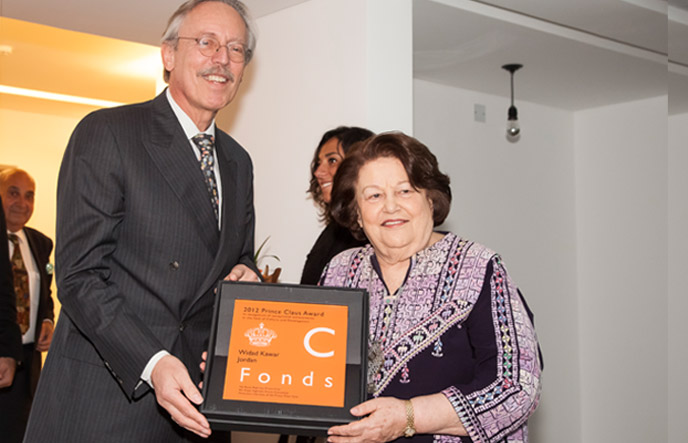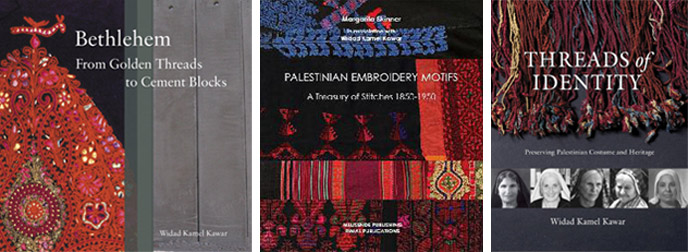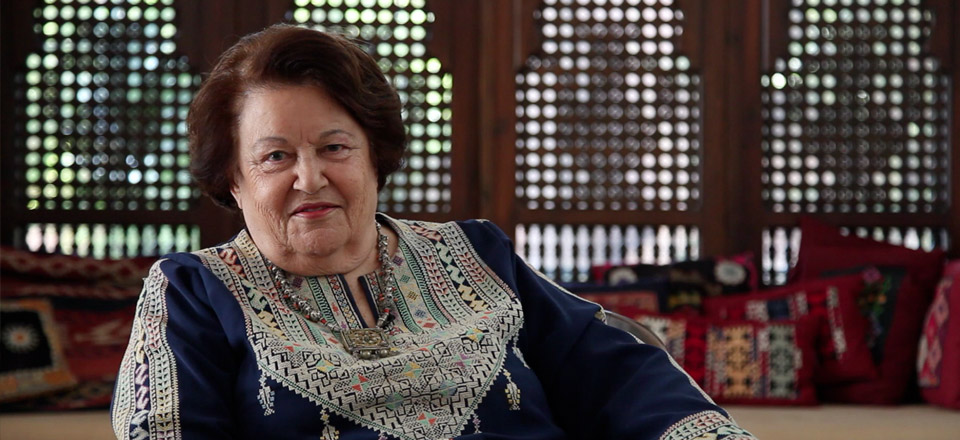وداد قعوار:
The Story
The Story
Widad Kamel Kawar was born in Tulkarem, in the Nablus area of the West Bank. The family soon moved from Tulkarem to Brummana and then, in 1941, to Bethlehem. During some vacations the family would go to Aboud, her mother’s village, in the Ramallah area. These holidays in Aboud instilled in her an understanding of Palestinian village life in the 1940s. There she learned about costume and embroidery, and also about the intricacies of social relations in the village, especially among women. She remembers that almost every day after lunch the women of Aboud, old and young, would put on their best clothes and get together to embroider. On one visit a relative gave her two thobs (traditional costumes) one of them is dating back to the 1800s. This was the start of her collection.
She married Kamel Kawar and moved to Amman where her husband and family were settled. It was not long before she started a family, but she carried on with her work. She was a member of the YWCA and the Women’s Auxiliary of UNRWA (United Nations Relief and Works Agency – a special body created to aid Palestinian refugees after 1948). Through these organizations she did volunteer work in two Palestinian refugee camps in Amman, Hussein and Wihdat. There she became acquainted with many refugee women and their way of life.
The 1967 war confronted her with an entirely new reality: all the villages of Palestine, like the country itself, were now occupied. This was a turning point: She started to collect genuine examples of the complete attire of each geographical area before they were lost or influenced by the emerging refugee camp styles. She also wanted to gather the items that women prepared for their marriage, such as embroidered cushion covers and home decorations, as well as handicrafts like straw work, weaving and pottery.
Widad has been a patron of the preservation and modernization of this art form through supporting artisans in both the Arab Region and outside it. She is a mentor to writers, journalists, researchers and museums. Her home has always open for anyone from around the world. She has succeeded in raising the awareness of people of the value of Arab textile heritage through many international exhibits. These exhibits have taken place in Bahrain, Denmark, France, Germany, Japan, Jordan, Iceland, Norway, Saudi Arabia, Singapore, Switzerland, United Kingdom and the United Arab Emirates. She has also published several books and articles. Over the years she has become an icon for the preservation and promotion of the disappearing Arab textile heritage. For this, she has received several medals from the government of Jordan. In addition, she has been the recipient of the Prince Klaus International Award for Culture and Development for “her invaluable contribution to securing global cultural heritage.

Awards
• Directorate of Heritage Award of the Government of Sharjah, 2014
• Prince Klaus International Award for culture and development, 2012
• Jordan Tourism Medal for her role in organizing the Seville World Expo, 1992
• King Hussein Medal, 1993
• Medal for Jarash Festival, 1986

List of Publications
The list below includes authored publications as well as contribution towards publications, especially exhibit catalogues.
• Seventeen Embroidery Techniques from Palestine: An Instruction Manual - Jerusalem, Palestine [2019]
• Threads of Identity: Preserving Palestinian Culture and Heritage - Amman, Jordan [2011]
• Contribution to BERG Encyclopedia of World Dress and Fashion Volume Four on Central and South West Asia [2010]
• Bethlehem: From Golden Threads to Cement Blocks - Amman, Jordan [2005]
• Cultural Treasures of Jordan [2001]
• Palestinian Embroidery, Traditional Fallahi Stitch. With Tania Nasir. National Ethnic Museum -Munich, Germany [1992]
• Costumes Speak. With Sally de Vries. Jordan Magazine - Washington, United States
• National Costumes of Jordan. The Art of Jordan. Museum of Mersyside - Liverpool, England
• 2000 Years of color. Kawar Collection and Mosaics of Jordan. Moesgard Museum - Aarhus, Denmark [1991]
• Memoire de Soie. Institute du Monde Arabe - Paris, France [1988]
• Pracht Und Geheimnis. Rautenstrauch-Joest Museum - Munich, Germany [1987]
• Costumes and Wedding Customs in Bayt Dajan. With Shelagh Weir. [1984]
• Weaving in Jordan - Amman, Jordan [1981]
• Costumes Dyed by the Sun - Tokyo, Japan [1982]



